 |
New York Architecture Images-New
York Bridges Triborough Bridge |
||||||||||||||||||||||||||||
| Contemporary black and white images on this page copyright Dave Frieder ( www.davefrieder.com ). Special thanks to Dave Frieder for permission to use images. | |||||||||||||||||||||||||||||
|
architect |
Othmar Ammann | ||||||||||||||||||||||||||||
|
location |
Connects Astoria Queens with Randalls Island | ||||||||||||||||||||||||||||
|
date |
1936 | ||||||||||||||||||||||||||||
|
style |
Structural Expressionism | ||||||||||||||||||||||||||||
 Harlem
River Lift Span Harlem
River Lift Span |
|||||||||||||||||||||||||||||
 Bronx
Crossing Span Bronx
Crossing Span |
|||||||||||||||||||||||||||||
 East
River Suspension Span East
River Suspension Span |
|||||||||||||||||||||||||||||
|
construction |
steel and concrete | ||||||||||||||||||||||||||||
|
type |
Suspension Bridge | ||||||||||||||||||||||||||||
|
data |
|
||||||||||||||||||||||||||||
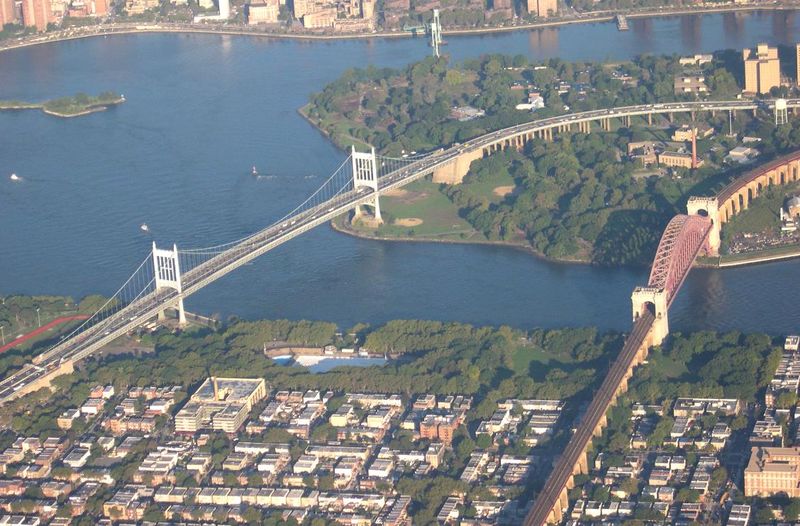 |
|||||||||||||||||||||||||||||
| Above image Dave Frieder (special thanks!). | |||||||||||||||||||||||||||||
.jpg) |
|||||||||||||||||||||||||||||
.jpg) .jpg) |
|||||||||||||||||||||||||||||
.jpg) |
|||||||||||||||||||||||||||||
.jpg) |
|||||||||||||||||||||||||||||
| Dave Frieder Gallery. Copyright Dave Frieder ( www.davefrieder.com ) | |||||||||||||||||||||||||||||
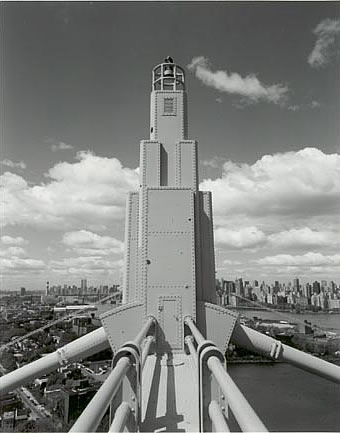
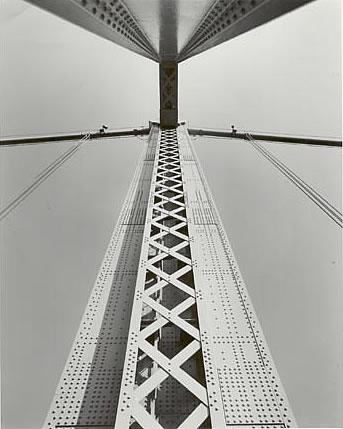
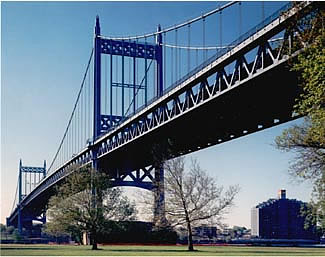
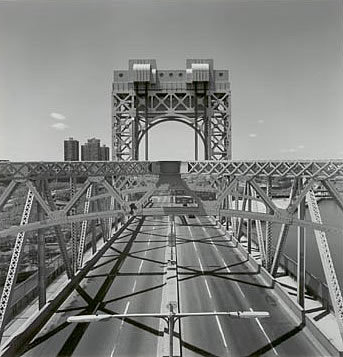
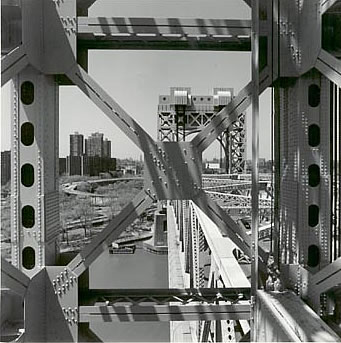
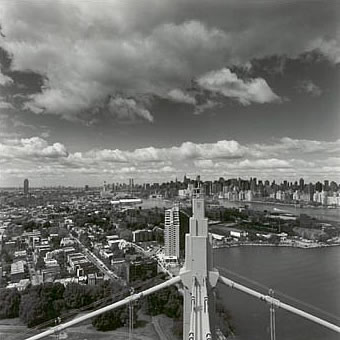 |
|||||||||||||||||||||||||||||
|
|
 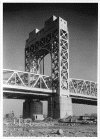 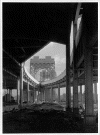  |
||||||||||||||||||||||||||||
|
images |
      |
||||||||||||||||||||||||||||
|
|
 |
||||||||||||||||||||||||||||
|
The Triborough Bridge is a complex of three bridges connecting the New
York City boroughs of the Bronx, Manhattan, and Queens, using what were
two islands, Ward's Island and Randall's Island as intermediate
rights-of-way between the water crossings. These two islands have been
consolidated by landfill. The bridges span the Hell Gate (a tidal channel of the East River), Harlem River, and Bronx Kill. Construction had begun on Black Friday in 1929, and the Triborough project's outlook began to look bleak. Othmar Ammann's assistance was enlisted to help simplify the structure. Ammann had collapsed the original two-deck roadway into one, requiring lighter towers, and thus, lighter piers. These cost-saving revisions saved $10 million on the towers alone. Using New Deal money, the project was resurrected in the early 1930s by Robert Moses and the bridge was opened to traffic on July 11, 1936. Its cost was greater than that of the Hoover Dam. The structure used concrete from factories from Maine to Mississippi. To make the casings for pouring the concrete a whole forest in Oregon was cut down.[2] The bridge is owned by the City of New York and operated by the Triborough Bridge and Tunnel Authority (TBTA), an affiliate agency of the Metropolitan Transportation Authority (New York). On January 9, 2008, New York State Governor Elliot Spitzer announced his proposal to rename the bridge the Robert F. Kennedy Memorial Bridge, in honor of the former New York Senator Robert F. Kennedy. Usage The toll revenues from the Triborough Bridge and the other bridges operated by the Triborough Bridge and Tunnel Authority (TBTA) were and are enormous, amounting to USD$933.1 million in 2002. The money from the bridge pays for a portion of the public transit subsidy for the New York City Transit Authority and the commuter railroads. The bridge carries approximately 200,000 vehicles per day. The bridge has sidewalks in all three legs. The TBTA officially requires bicyclists to walk their bicycles across, but the signs stating this unpopular requirement are usually ignored by bicyclists citing the very long distance of the bridge. Stairs on the 2 km (1.3 mile) Queens leg impede handicapped access. The Queens stairway along the southern side was demolished at the beginning of the 21st century, thus isolating that walkway, but the ramp of the Wards Island end of the walkway along the northern side was improved in 2007. The two sidewalks of the Bronx span are connected to only one ramp at the Randalls Island end. As of June 25, 2007, the crossing charge for a two-axle passenger vehicle is $4.50 charged between any two boroughs or from any borough to Randall's Island, with a $0.50 discount for E-ZPass users. The crossing charge for a motorcycle is $2.00 charged in each direction, with a $0.25 discount for E-ZPass users. The return trip from Randall's Island to any borough is free. |
|||||||||||||||||||||||||||||
|
The Triborough Bridge, the authority's
flagship facility, opened in 1936. It is actually three bridges, a
viaduct, and 14 miles of approach roads connecting Manhattan, Queens,
and the Bronx.
The Manhattan branch is the Harlem River Lift Bridge, which links the Harlem River Drive, the FDR Drive, and 125th Street, Harlem's commercial and cultural center. The Bronx Crossing leads motorists to points north via the Bruckner and Deegan expressways and, more locally, to the neighborhoods of the South Bronx and the Port Morris Industrial Area. The longest span of the Triborough Bridge, the East River Suspension Bridge to Queens, connects with the Grand Central Parkway and the Brooklyn-Queens Expressway and to Astoria's residential areas, restaurants, and shops. The bridge's three branches meet on Randall's Island, where an interchange and two toll plazas sort out traffic flowing in 12 directions and provide access to the island itself. Adjacent to the Manhattan toll plaza is the Robert Moses Administration Building, the TBTA's headquarters. Randall's Island is largely city parkland; that includes Downing Stadium, softball fields, tennis courts, picnic areas, and some city facilities. In 1951, the TBTA constructed and gave to the city a pedestrian bridge between 103rd Street in Manhattan and Wards Island, providing another access by foot to Randall's Island and Wards Island. NOT ONE BRIDGE, BUT MANY: The Triborough Bridge is not simply a single span, but rather is a complex comprised of three long-span bridges, a number of smaller bridges and viaducts, fourteen miles of approach highways and parkways, parks and recreational facilities, and administrative offices for the Triborough Bridge and Tunnel Authority. To appreciate the magnitude of the project, it can only be viewed in its entirety from above. Plans for connecting
Manhattan, Queens and the Bronx were first announced by Edward A. Byrne,
chief engineer of the New York City Department of Plant and Structures,
in 1916. While its construction had been long recommended by local
officials, the Triborough Bridge did not receive any funding until 1925,
when the city appropriated funds for surveys, test borings and
structural plans. |
|||||||||||||||||||||||||||||